You’ll hear it first, Mosi-oa-Tunya or ‘The Smoke That Thunders’: light, deep reverberations that grow in volume as you edge closer to witness this immense natural phenomenon, and face a vast, soft cloud, shifting idly a few meters above ground.
After healthy summer rains, when Victoria Falls is at its most powerful, this cloud is ever present, fed by the waterfall itself. The sheer force of the world’s largest sheet of falling water propels waves of misty spray 400m into the air.
By the time you enter the mists, those light reverberations are replaced by the awe-inspiring roar. This immense sound of the falls, the heart-stopping views, and the almost-surreal beauty of glinting rainbows in the clouds of spray create multi-sensory, all-encompassing experiences. And deep respect for the massive power of this African natural wonder.
Victoria Falls is an all-year-round destination, a spectacular attraction no matter what time of year you visit. Many travelers will visit multiple times within a year, as certain seasons lend themselves to particular attractions. This is shown by the graphic below.
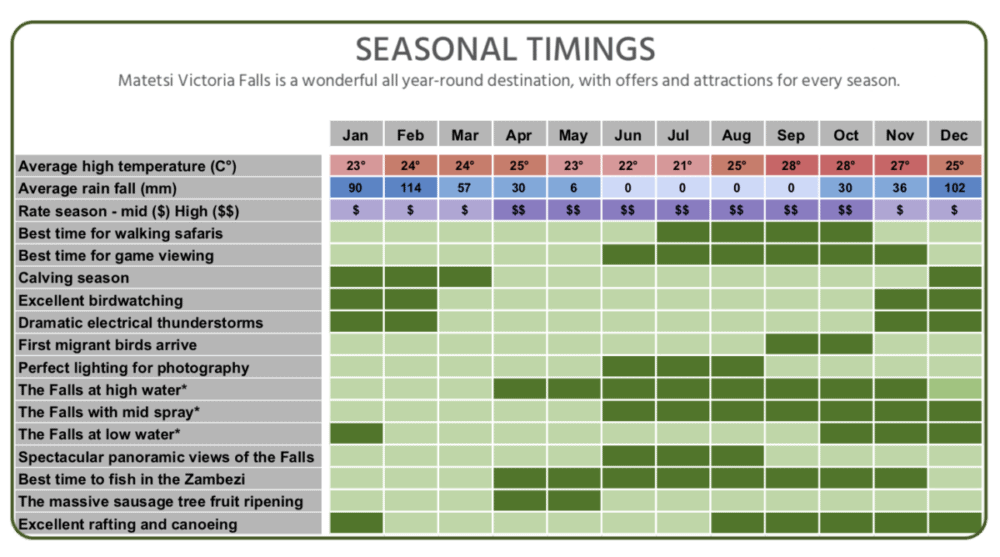
A breakdown of the seasons in Southern Africa, and how they affect various attractions around Victoria Falls
Traveling to Victoria Falls, the importance of when to visit
Victoria Falls is a truly spectacular attraction throughout the year, the surrounding African wilderness flourishes in Zambia and Zimbabwe’s warm climate, while the constant spray from the falls creates a rainforest type ecosystem. As with all things of nature, the falls and surrounding attractions evolve with the seasons, giving you varied and different experiences depending on the time of year you visit.
Immediately following the rainy season, Victoria Falls is at its most powerful. While out of peak safari season, the surrounding wilderness areas are lush and luminous-green, making for exciting game viewing (high contrast lion and other sightings as opposed to the more camouflaging ‘golden’ savanna hues in drier months), and stunning light and photographic opportunities. The high water-levels of the Zambezi River, which make the falls so powerful at this time, also limit certain activities. For example, white water rafting on the Zambezi River and swimming in Devil’s Pool from Livingstone Island are only safe, and offered, in low-water and mid-water seasons.
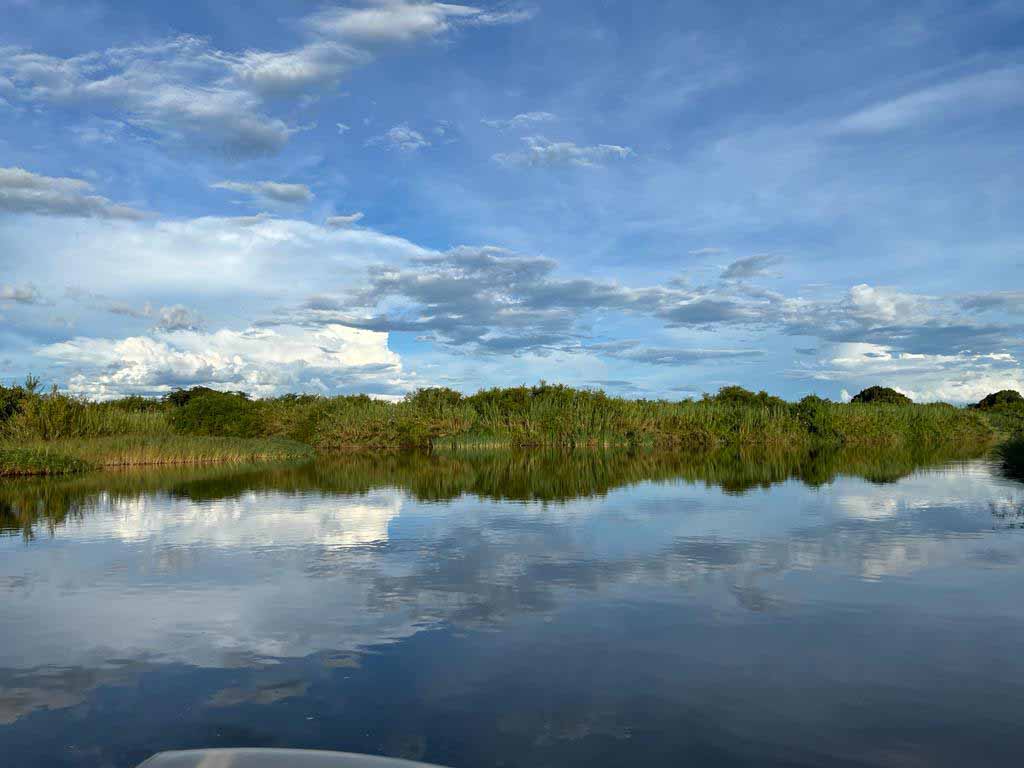
The Zambezi River
Summer/Wet Season (September → March)
During late Summer, you can expect hot, wet weather. Scorching midday African sun, deep pools of welcome shade from massive old riverine trees, post-lunch lazy siestas, and afternoon showers or deluges that refresh and reinvigorate. Then sparkling sunset-wilderness unfolding around you, as evening watering visits and preparations for wildlife night-time activities are revealed along with breath-taking sunsets and incredible, almost-theatrical lighting effects from the setting sun.
The late summers in this area, from December onwards, are characterised by large amounts of rain. For the most part, this falls during the latter half of summer, with short, but substantial afternoon thunderstorms. At the beginning of the summer (September to late November), before the big rains, the falls are at their lowest flows, but then steadily grow in strength as the rains feed the Zambezi River.
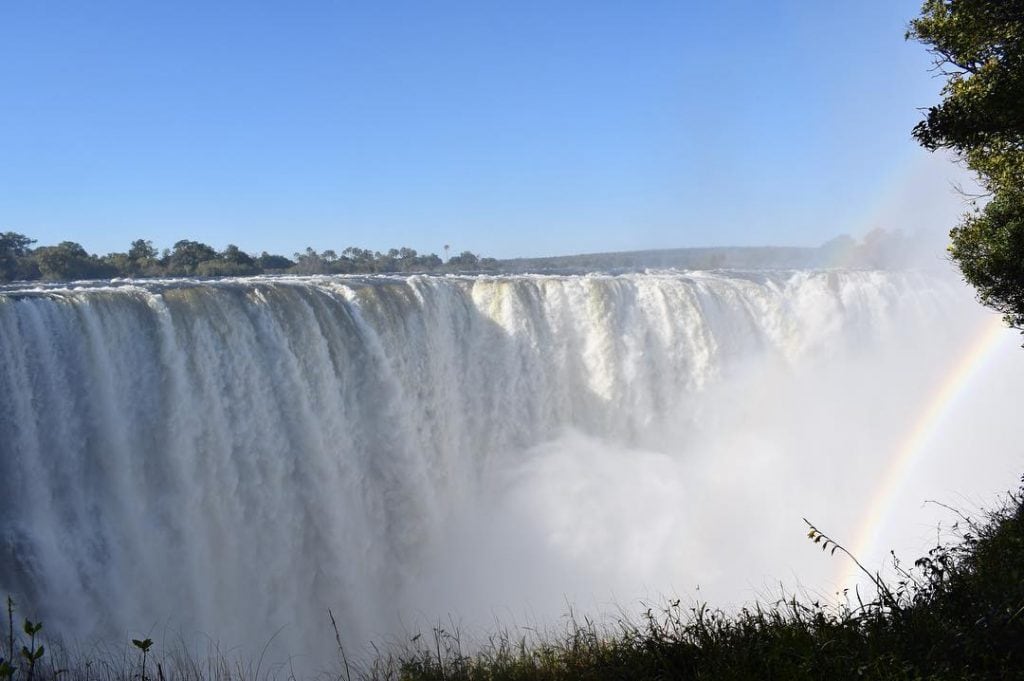
Victoria falls flowing at full force. Water levels are high after much rain.
Each day, the hot African sun beats down on the savanna, heating everything, including the Zambezi. This makes swimming in Devil’s Pool, as well as various river activities, such as white water rafting, an absolute treat. However, deep into the wet season, from around February or March, once much rain has bloated the Zambezi, these activities become unsafe.
Game viewing once the rains begin, can be challenging as locating and spotting game becomes more exacting. Expert rangers and trackers are important, and the landscape is extraordinarily beautiful and varied during this time, from emerald grassy plains to intriguing massive baobabs and the mystical rainforest’s most striking African Ebony trees.
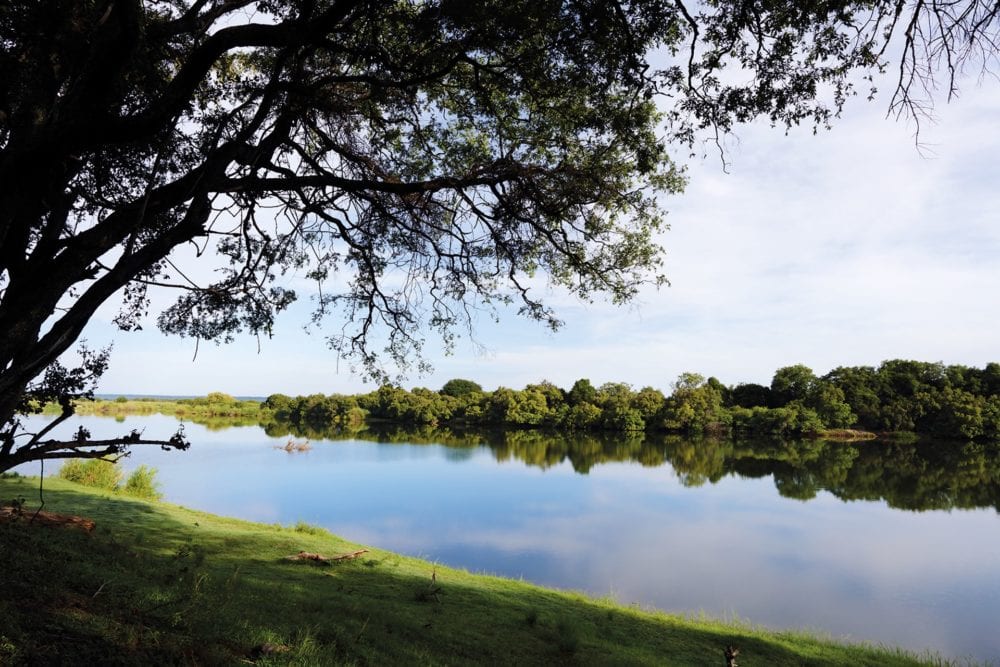
The Zambezi River from the Matetsi Victoria Falls swimming pool. The savanna is lush and green after Summer rains.
For a detailed, month-to-month breakdown of the Summer months, see the two subsequent sections…
Victoria Falls in September, October, November, and December (Start of Summer/Wet season)
This period starts with the end of the dry season. Before the first rains, which one can expect in late November, the air is hot and dry, with October generally recording the highest temperatures of the year, sometimes rising above 40°C (100°F).
During this time, water levels are at their lowest. Despite the first rains, it takes time for this water to make its way from the distant highlands, through a sophisticated network of rivers and gorges, into the mighty Zambezi River.
The rains bring with them great relief, as well as humidity. They transform this dusty landscape into a lush green savanna. After November, temperatures remain hot, but quickly become more bearable.
The low water levels guarantee panoramic views, unobstructed by spray. You will be witnessing the falls at its least powerful, but with much of its rock face exposed, this is a geologist’s dream. Although, if you wish to see the largest sheet of falling water, this is not the ideal time of the year, you may be left slightly disappointed. A helicopter flight over the falls, to compliment a walking tour, is still highly recommended. With an aerial view, you’re able to properly appreciate the extent of the falls.
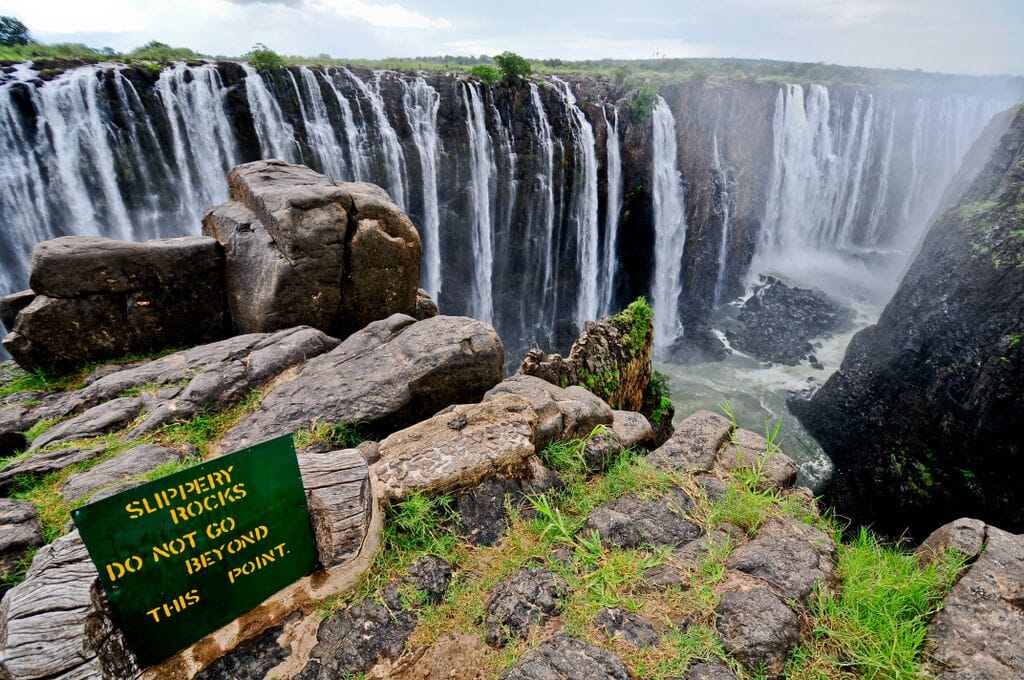
Victoria Falls after some rain, water levels are relatively low. Image by Andy Lowe.
With the water warming as Summer progresses, this is the perfect time for swimming and watersports, such as white water rafting. The lower water levels make these activities safe, allowing you to visit Livingston Island and swim in Devil’s Pool.
With hot days and warm river water, you may want to take after a hippo and cool off lounging with just your head above the surface. At the edge of the falls, Devil’s Pool is the perfect place for exactly this, with crystal clear river water flowing by before taking an almighty leap. Otherwise, if swimming near the edge doesn’t appeal to you, enjoy a dip at Matetsi Victoria Falls. With your own private plunge pool and the 20m lap pool, you are spoiled for choice.
Before the first rains, which usually arrive at the end of November, game viewing is incredible. It is the driest and dustiest time of year, which means thin and sparse vegetation. This makes spotting game much easier, as animals stand out against the sparse and barren landscape, rather than camouflaging amongst thick vegetation.
Furthermore, during this extremely dry season, animals are desperate for water. They congregate around water sources such as rivers and waterholes, making them easy to locate. At this time of year, the heat as well as the dry and dusty landscape can take some getting used to, but it’s worth it considering the incredible game viewing.

Buffalo compete for space around a crowded water source. Image by Andy Lowe.
Finally, after many relentlessly dry months, the heavens open. Together the entire savanna embraces this new lease on life. Hear birds chirping, zebras braying, and the distant trumpet of an elephant. Some say that just after the first rains, if you listen really closely, you will hear a faint whisper – Toto’s voice “bless[ing] the rains down in Africa”.
However, don’t be so quick to celebrate with the rest of the savanna, the rain will have a distinctly negative effect on your game viewing experience. Wildlife is no longer forced to congregate around small water sources, rather spreading out over hundreds of kilometers. They are spoilt with an entire savanna of fresh vegetation and groundwater.
Although there is still a large amount of game to be found, it is no longer predictably concentrated around a few water sources, and therefore more difficult to locate. However, the new rains do give the savanna a new lease on life. Almost immediately after the first rain, the landscape undergoes an extraordinary transformation – from a brown dust-bowl to a lush grassland.
Not long after this green transformation, do the savanna’s expecting mothers give birth. The newly lush landscape will be teeming with the cutest youngsters, beginning to get a grip on life in an African grassland.
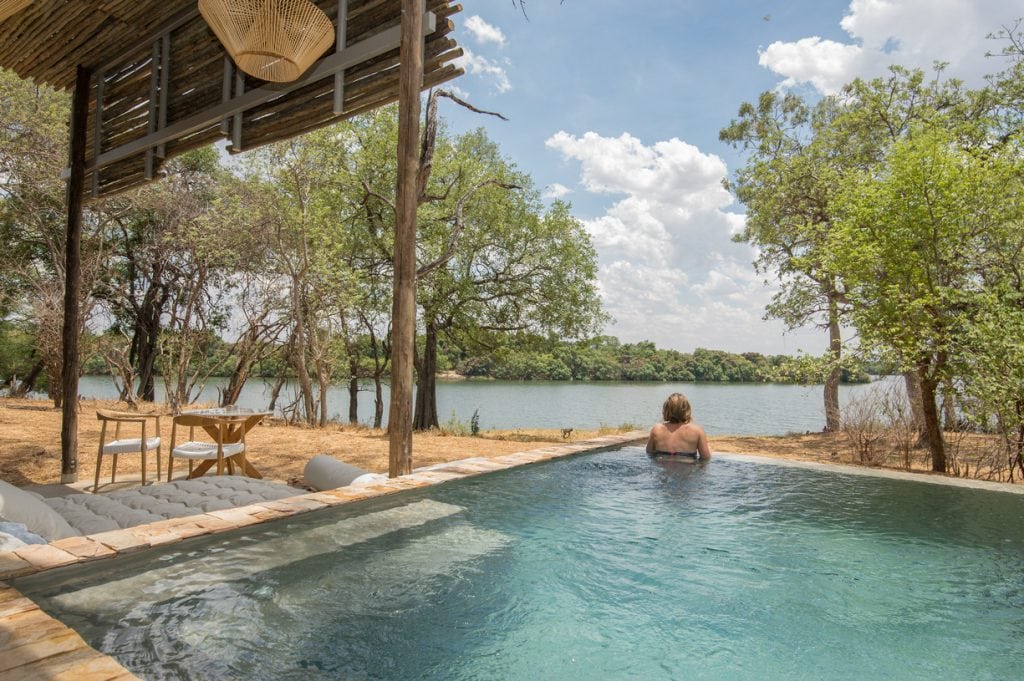
Watch the river swell with each rain from the pool at Matetsi Victoria Falls, a luxury safari lodge. Image by Andy Lowe.
From January until the end of March (End of Summer/Rainy Season)
This is the height of the rainy season. It is very hot and humid, with temperatures often exceeding 32°C (90°F). Tropical afternoon thunderstorms are common, especially on particularly hot days. However, they pass quickly, conveniently making way for clear African sunsets.
However, beware that as the Summer rains feed the ever-swelling Zambezi River, your window to enjoy this body of water shrinks. The water level eventually becomes too high, making visiting Livingston Island, swimming in Devil’s Pool, and other watersports such as white water rafting unsafe. This usually occurs in February, so from then, you will have to stick to the swimming pool at your luxury safari lodge.
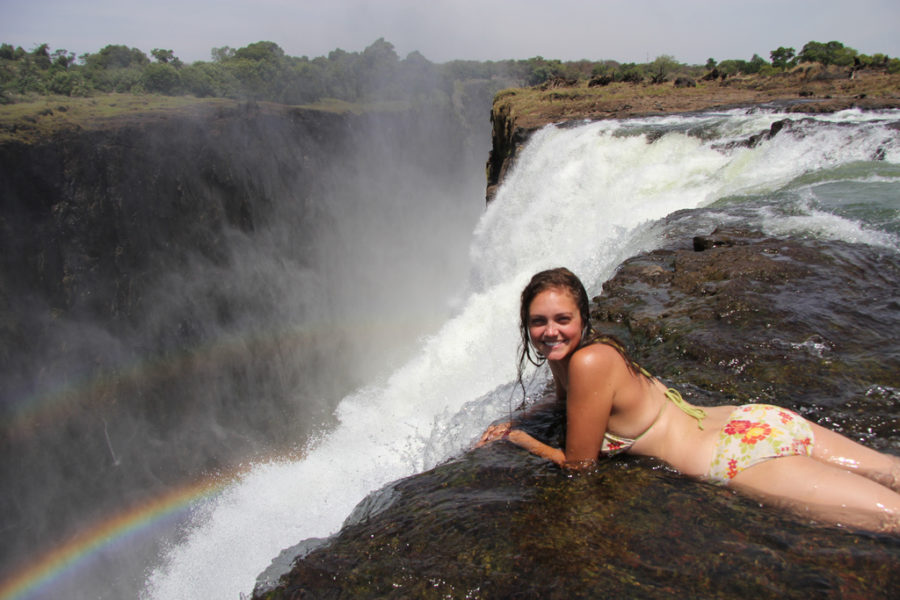
Peek over the waterfall edge at Devils Pool.
By now, months of consistent rain will have brought about the Emerald Season, better known as the Green Season. It is the time of year when the savanna flourishes. Lush green grass spotted with blooming flowers, seasonal birds showing off their courtship plumage, and butterflies fluttering in the background of it all.
This is the time of year for photographers. The lush green savanna combines beautifully with the all-consuming African sky above. Photographers coming to this area are especially excitable following afternoon thunderstorms. They tend to clear just before sunset, leaving a magnificent palette of warm colours reflecting off the passing clouds.

The Emerald/Green Season in full swing.
However, the Green Season also has a downside, less than ideal game viewing conditions. Although there is an abundance of game within the area, the thick vegetation during this time makes it difficult to spot game. Animals can easily stay out of sight behind the flourishing bushveld.
Furthermore, during the wet months, game is spread throughout these open-border reserves, making them more difficult to locate. This is because an abundance of groundwater means that animals have a choice of where to drink. They no longer congregate in such numbers around ever-flowing water sources, making their whereabouts predictable.
Victoria Falls Dry Season / Winter (April → August)
It is slightly cooler during the Winter months, making the weather more manageable for some. Spend your days warm, basking in the African sunlight. Although it does become surprisingly cold at night, it is the dry season, so you do not have to worry about being cold and wet.
Although the slightly cooler weather does mean colder water, it does not become uncomfortably cold. This means, once the water levels drop around July, taking a dip at Devil’s Pool and activities such as white water rafting are open up for the season. The water levels depend on the seasons, and the amount of rainfall that year, so it’s best to check with the locals as to when the Zambezi River’s summer swelling to expected to subside. The water levels usually start to drop in April, once the majority of the Summer rains have made the leap over Victoria Falls. However, a couple months may pass before levels have dropped enough to enable access to Devil’s pool and the white-water rafting season to open.

Devil’s Pool is submerged as the Summer rains make their way over the falls.
As far as game viewing is concerned, it gets better as the dry season takes hold. The lack of rain slowly thins out the vegetation, turning the once lush green paradise into a brown, more sparsely populated landscape. The sunbaked yellow landscape has it’s own beauty, especially in the golden hours before sunset. Furthermore, the more sparse vegetation makes game much easier to see
Furthermore, as the groundwater dries, wildlife congregate around ever-flowing water sources such as the Zambezi River and waterholes. This makes locating animals easier as their movements become more predictable.
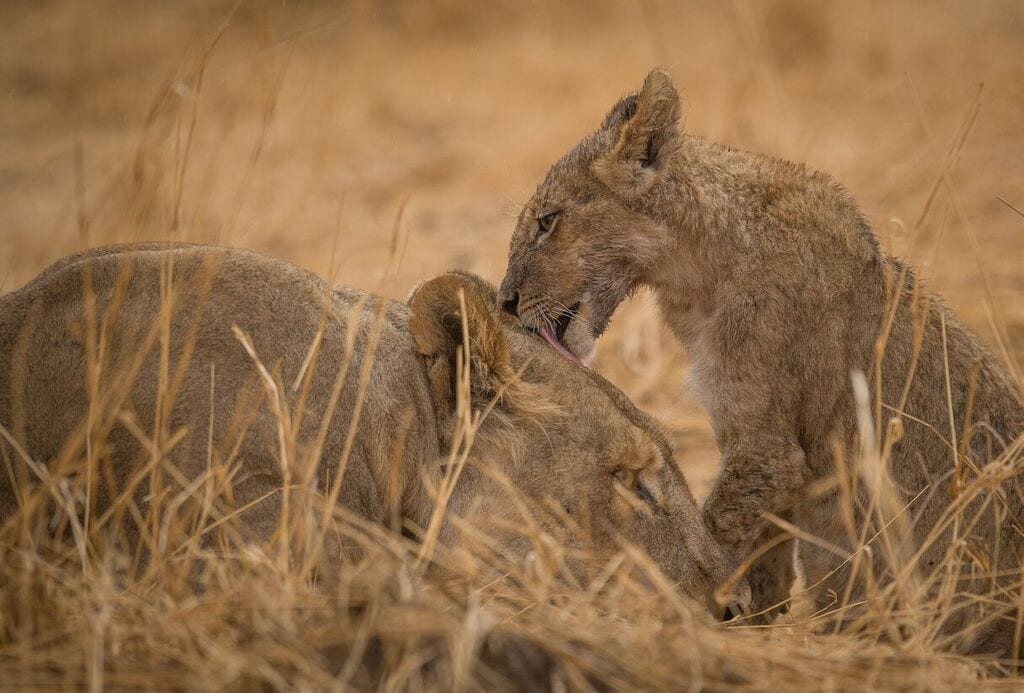
Most game is easily spotted in the dry savanna, but lion blend in seamlessly with the brown backdrop. Image by Andy Lowe.
For a detailed, month-to-month breakdown of the Winter months, see the two subsequent sections…
Victoria falls in April, May, and June (Start of Winter/Dry Season)
A winter of sorts begins just after the last Summer rains. With days averaging around 26°C, and rain a rarity, you will remain comfortably warm.
The Zambezi River is visibly bloated and roaring at full velocity at the beginning of the dry season, with much of the summer rain still making its way down towards Victoria Falls. This is when the falls is at its most powerful. The great volume of water flowing over the waterfall’s edge is truly awe-inspiring, as might be expected from the world’s largest falling sheet of flowing water.
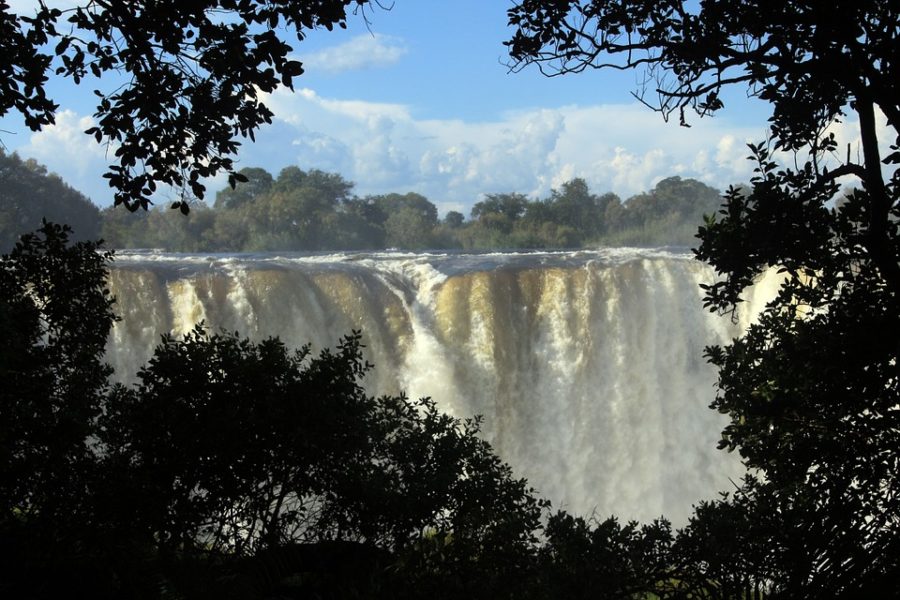
Water levels are at their highest, creating a powerful spectacle.
The immense force of the falling water propels large columns of water vapour high above the waterfall edge. Although absolutely beautiful, this does affect visibility from certain viewpoints. Despite this, there are still excellent views from both the Zimbabwean and Zambian side of the falls.
Furthermore, this is the best time for a helicopter tour. Experience the might of Victoria Falls from above, feel the power of The Smoke That Thunders.

Victoria Falls from a helicopter. The largest sheet of flowing water at full force.
All in all, if a view of Victoria falls is what you are looking for, this is when you want to visit. The high water levels will make for the most spectacular viewing experience. Unfortunately, these high water levels also make swimming in Devil’s Pool and certain water sports too dangerous.
On the other hand, game viewing remains relatively difficult. This is because the savanna remains lush, groundwater plentiful, both surviving off summer rains. The thick vegetation makes it difficult to spot game, while the abundance of groundwater makes animals more difficult to locate. This is because they are not forced to congregate around ever-flowing water sources.
Visiting Victoria falls in July and August (End of Winter/dry season)
Although the coldest time of the year, the end of winter remains a comfortably average high temperature of 26°C. It gets surprisingly cold at night, but as winter is the dry season, you do not have to worry about rain. You’ll want to pack layers, as chilly early mornings will find you wrapped up in beanies and scarfs. These will be discarded as the sun rises overhead, leaving you comfortably warm in a t-shirt will be more comfortable. However, keep your layers close as they will be again be needed once the sun starts to set.
By now, the summer rains have made their way past the falls, leaving a lower water level. This means a less powerful and impressive waterfall, but also minimal spray. It’s a trade-off, greater visibility for a less awe-inspiring spectacle.
Furthermore, a more gently flowing Zambezi River allows the attraction’s various water sports to recommence. Again one is able to swim in Devil’s Pool and float down the river on a white water raft.
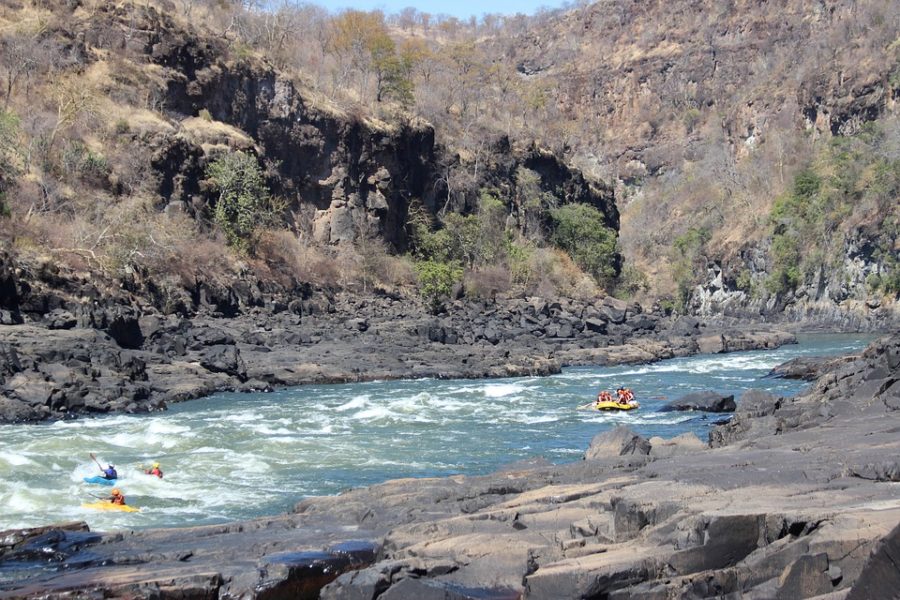
Whitewater rafting down the Zambezi River.
On the other hand, this is prime Game viewing season. As the groundwater dries, herds are forced to flock towards ever-flowing water sources. The result, a concentrated abundance of easily located game.
Furthermore, months without rain has left the savanna sparsely populated by thin vegetation, therefore making game easy to spot. Although the dry landscape is can be considered rather harsh, the concentration of game makes for a remarkable experience.
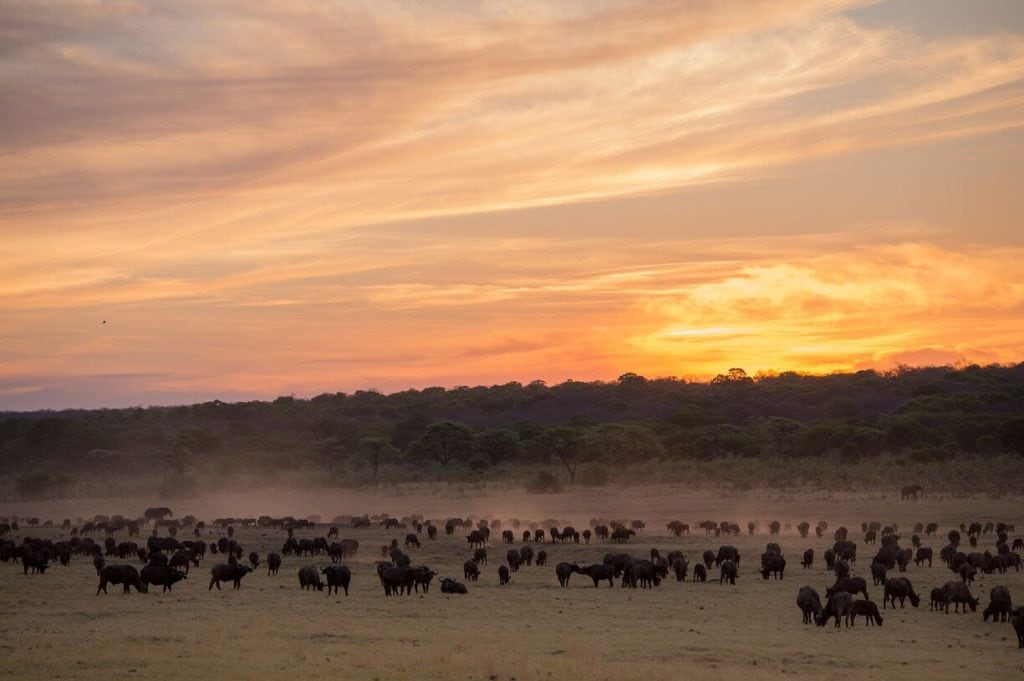
The savanna is crowded as game make their way to the few remaining watering holes. Image by Andy Lowe.
In Summary
Victoria Falls is a fantastic all-year-round destination. No matter the season, this multifaceted attraction has something spectacular to offer.
The falls and surrounding attractions are, however, very different depending on what time of year/season you visit. Therefore, in order to maximize your time at Victoria Falls, acquaint yourself with her seasons and choose the season that suits you.








